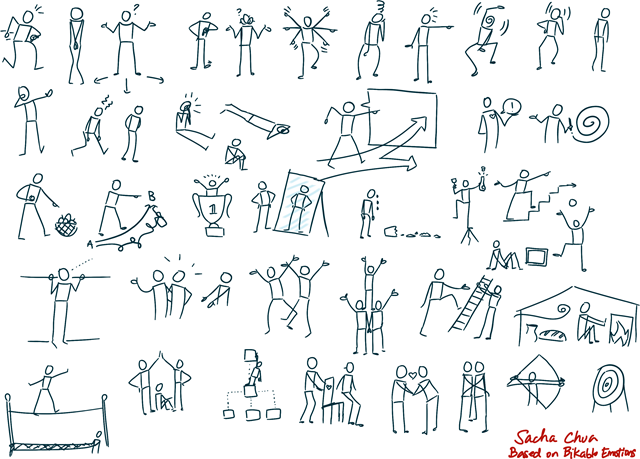Sketchnote Lessons: Drawing Emotions
Posted: - Modified: | drawing, sketches, visualWant to make your drawings more interesting? Add emotions! Drawings of emotions can communicate so much more than words describing emotions, and they do so in an immediate, visceral way. For example, consider the list of words below, and the faces beneath them.
Even if you don’t think you’re an artist, you can draw basic emotions easily. Simple combinations of eyebrows and mouths say a lot. You can show different degrees of emotions by emphasizing parts.
You can combine emotions, too. For example, angry eyebrows + happy smile = evil overlord plotting to conquer the world. >=)
Play around, and you’ll find even more emotions that you can express with small changes to the face. For inspiration, you can look at smileys and emoticons.
Icons and symbols let you be even more expressive. You can pick these up from comics and smileys.
Emotions aren’t just expressed with the face. Posture can communicate emotions powerfully too. Explore the physicality of emotions by looking at how actors show feelings, or by imagining yourself feeling those emotions.
You can also show emotions in how people relate to each other.
Metaphors are fun to play with, too.
Learning how to draw emotions isn’t just useful for sketchnoting. You can draw emotions in order to understand other people better. Mindmaps or empathy maps can help. You can draw your own emotions, too. When I’m faced with a difficult situation or a confusing tangle of emotions, I try to break down the different emotions I feel and the reasons why I feel that way. When you understand why you’re happy and sad and worried and excited all at the same time, it’s easier to move forward.
Want to learn more about drawing emotions? The best resource I’ve found so far is the Bikablo Emotions book, which has a lot of full-body emotions. Here’s a sample of the drawings I made based on part of the Bikablo Emotions book. (There are even more emotions in the book – check it out!)
Children’s books are a good source of emotions. I remember loving the Mr. Men and Little Miss series when I was growing up, and I look forward to discovering other wonderful illustrations as I go through the library’s collections. =)
Comics are another great way to learn more about expressing emotions, from the concise forms of newspaper strips to more elaborate drawings in comic books.
And then there’s learning about all these emotions in the first place, because it helps to be able to recognize the emotion and give it a name. Wikipedia has a few good pages: Contrasting and categorization of emotions, Emotion classification. HUMAINE proposes a classification of 48 emotions (see Wikipedia for an easier-to-read list) The Center for Nonviolent Communication lists 259 emotions in their feelings inventory.
I’m thinking of going through those lists and practising drawing all these different emotions. Want to join me? I’ll post stuff here once in a while, and I’d love it if you sent me links to your drawings!









7 comments
耀华 王
2013-07-12T15:23:44Zyou Genius, love you so much
Patricia Kambitsch
2013-07-24T13:21:38Zstunning! sure would like to see you post here http://www.flickr.com/group...
Marija
2014-03-17T06:41:28ZTotally cool! Thanks for this post!
sachac
2014-03-22T02:21:23ZYou're welcome! I'd love to see what you draw.
Timo
2016-12-19T13:23:51ZGreat work, I love your simple tutorials! Sweet style btw. .-)
Linked to your page on my german sketchnoting website (https://sketchnoting.net/re...
marry
2021-01-26T19:35:29Zhii
chow
2022-08-14T02:22:04Zawesome